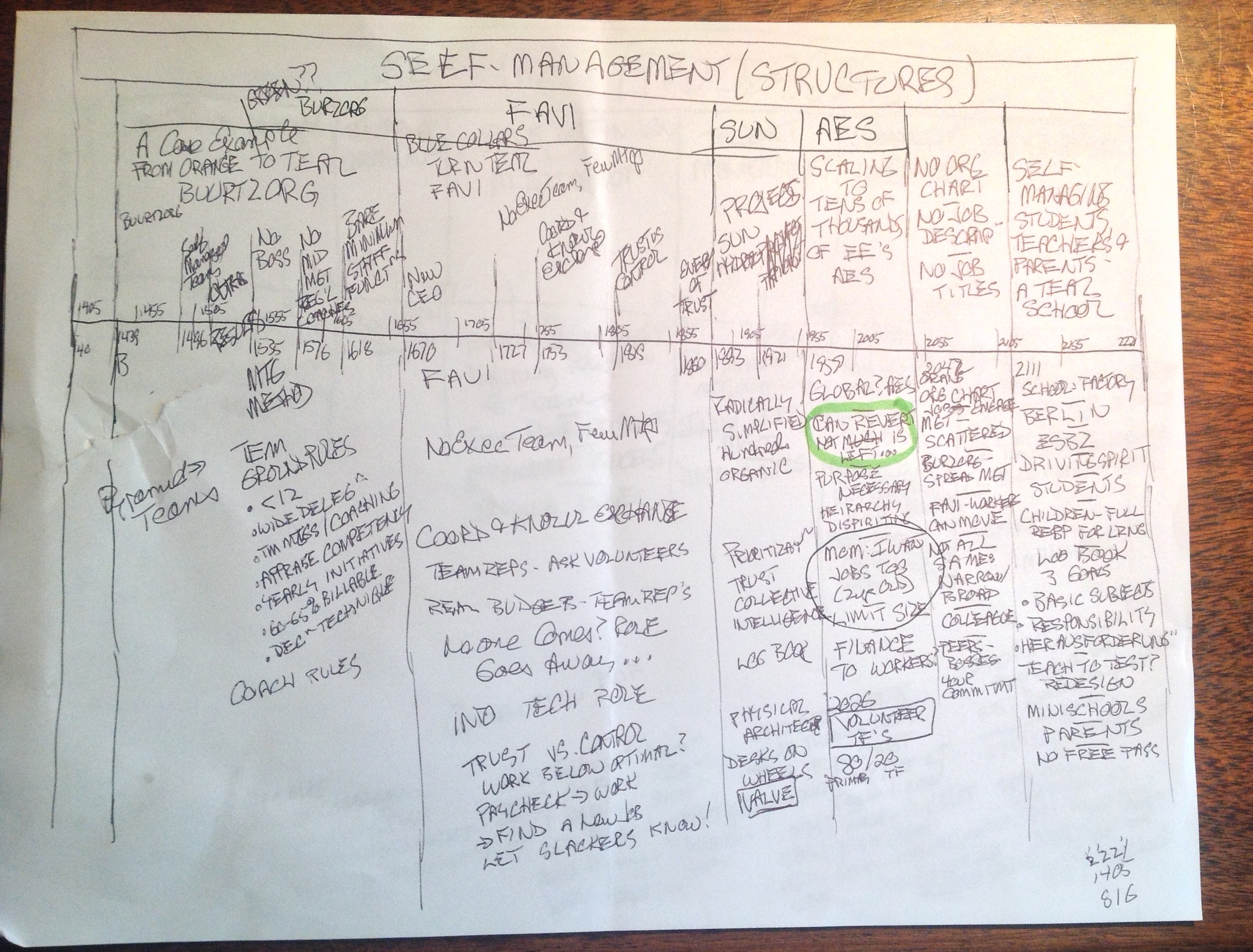Call in number: (712) 432-1212 Meeting ID: 630-021-158 We will record it and post notes afterward.

Welcome. Get someone to take notes / record the call.
Go around each person introduce themself briefly — name, your location, a highlight from the day, one bit from this section on self-management that caught your attention.
Review the task of the call — go through each section, share insights from the book, examples from your experience, questions and insights that came up.
Go through chapter 2.1 briefly as a review, both the 3 breakthroughs and the organizations featured.
We had 2 calls last week. Tuesday at 6 pm Arizona time, John Epps, Steve Harrington, Sally Kasner, Christine Whitney Sanchez, Nileen Verbeeten, Richard West, Jim Wiegel all joined in. We talked through 2.1 Three Breakthroughs and a Metaphor, then spent the rest of the call going through the details of self management structures in chapter 2.2. We touched in to 2.3 Self-Management Processes, then decided to look further on that next week.
Want to listen in? (apologies, I did not start recording promptly)
Wednesday at 7 am Arizona time, Larry Philbrook and Jim Wiegel went back through Chapters 2.1 and 2.2. Listen in here
No note taking on either call, however, we did generate a beginning list of key characteristics of the structures for Self-Management
Both Sally Kasner and Marissa Theisen sent the link below on Sociocracy.
Hi Jim. I saw this article today and thought it sounded very similar to the structures described in Reinventing Organizations. If you think it’s relevant, feel free to share with others in our group. Hope the call yesterday was good. Sorry to miss it. Marissa
Sociocracy: An Organizational Structure for Distributed Leadership
What kinds of employees do we really want in the nonprofit sector? With all our talk of a need for “leaderful organizations,” there are fewer discussions of what that really requires, though there is at least a half-century of literature and practice on the subject. And guess what? A good deal of it emerged from the same theoretical base as cybernetics, often mixed with some feminist theory. But shifting away from the dominant paradigm of command and control requires a culture shift for many. Here is one take to help inform.
Reflection on Chapter 2.2 Self-Management (Structures) Our two calls, May 27 and 28, generated this rough list describing structures of self-management (“for example, how the pyramid makes way for teams and how typical staff functions can be embedded within the teams”)
1. Vigilance and resolve at the top, to move forward, to not fall back into hierarchical ways, level of attention to shun tiered management, avoidance of creep (the pressure to “go back” to a pyramid)
2. Peer to peer availability to coach and be coached
3. Interdependence within a team. Marketing, shipping, machine operation, keep one another busy
4. Most people are headed in the right direction, invested in the work. 80% of them. A belief that people can and will step up, learn and grow
5. Look for what is needed and not being done, and stepping up to do it, also letting go
6. Not anarchy, a collaborative sense across the organization
7. Structured teams of a doable size
8. Open participation in teams, participants come and go
9. Resist building expert / staff functions, reverse authority and power of support functions, replace with coaching, outside consultants
10. Structured interdependence within and among teams
A NOTE ON THESE CHARTS AND DIAGRAMS. When I am actually “studying” a book or article, I try to set up a bit of a conversation between myself and the writing and the writer. Instead of “just reading” I try to get a sense of the structure of the piece — the chapter titles and also the amount of space the author gives to each topic. The horizontal line divided into sections (sometimes chapters, sometimes paragraphs, in this instance, kindle “loc’s” whatever they are) creates a space on the paper to record my “conversation”. I try to be a good listener and jot down what is actually being said, but at times I react and something is circled or I insert question marks or a comment. The notes on the paper give me a way to remember, plus going back and forth between reading and jotting notes activates a couple of different brain functions which keeps me young, vital and good looking 😉